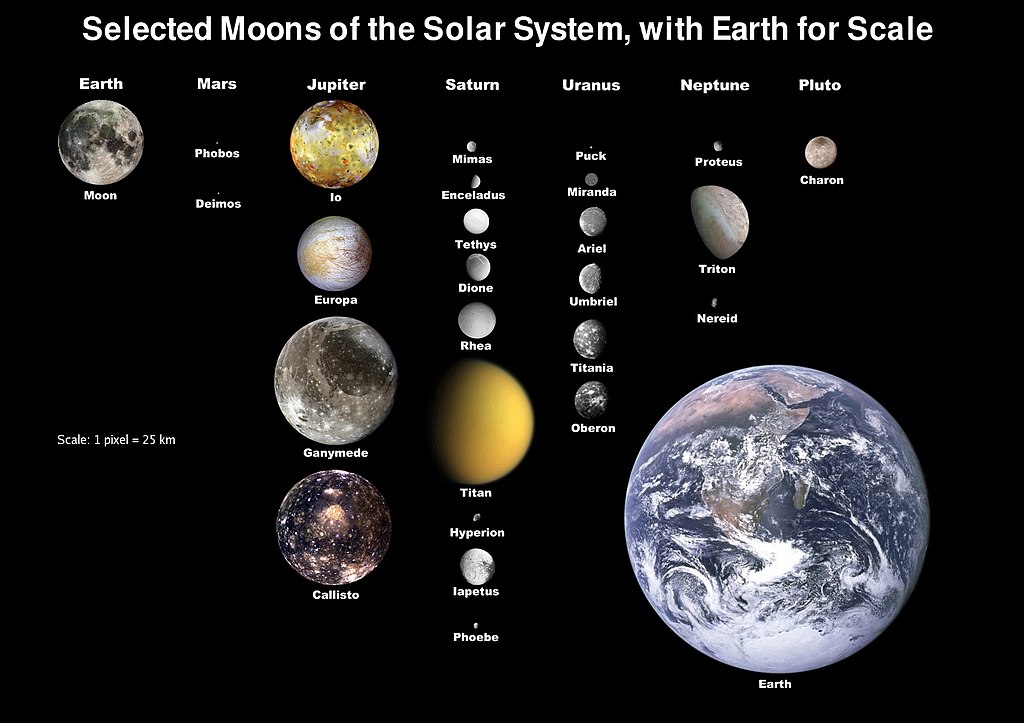
Caption: Especially interesting moons of the Solar System shown to-scale with the Earth shown to-scale for comparison.
These moons have been selected for large size or some other special feature of interest.
Features:
- The displayed
moons plus
a few others
(in order of increasing mean orbital radius)
for each parent
planet or other
Solar System object
are given below with mean
diameter in some cases
(in brackets)
and moon-size order for the largest ones (in brackets):
- Earth: Moon (3474, 5th).
- Mars (see Martian moons): Martian moons Phobos (22.2 km), Deimos (12.4 km). The Martian moons were discovered by Asaph Hall (1829--1907) in 1877. The tidal force is causing Phobos to inspiral to its eventual doom and Deimos to outspiral (see Wikipedia: Martian Moons: Characteristics).
- 243 Ida (an asteroid asteroid belt): Dactyl (about 1.5 km).
- Jupiter (see Jovian moons, Galilean moons): Io (3643, 4th), Europa (3122 km, 6th), Ganymede (5268 km, 1st), Callisto (4821 km, 3rd).
- Saturn: (see Saturnian moons): Mimas, Enceladus, Tethys, Dione, Rhea (1528, 9th), Titan (5152 km, 2nd), Hyperion, Iapetus (1469, 11th), Phoebe.
- Uranus (see Uranian moons): Puck, Miranda, Ariel, Umbriel, Titania (1577 km, 8th), Oberon (1523 km, 10th).
- Neptune (see Neptunian moons): Proteus, Triton (2707 km, 7th), Nereid.
- Pluto (ex-planet, dwarf planet, see Plutonian moons): Charon (1207 km, 12th).
- Eris (dwarf planet): Dysnomia (of order 300 km).
- The largest Solar-System
moons
in order of decreasing diameter are:
-
Ganymede (5268 km, 1st),
Titan (5152 km, 2nd),
Callisto (4821 km, 3rd),
Io (3643, 4th),
Moon (3474, 5th),
Europa (3122 km, 6th),
Triton (2707 km, 7th),
Titania (1577 km, 8th),
Rhea (1528, 9th),
Oberon (1523 km, 10th),
Iapetus (1469, 11th),
Charon (1207 km, 12th).
- Some folks think that largest moons
are really just small planets
that orbit other planets.
- The moons of
minor planet
(astro-bodies
too small to be planets)
are called minor-planet moons
and just minor planet themselves.
- Very small moons have been called,
unofficially, moonlets.
- There are NO known
moons of moons
in the Solar System, but
some tiny ones may exist.
Moons of moons of certainly exist in some other planetary systems.
- Moons
in other planetary systems
are called exomoons when there
is some need to distinguish them from
Solar-System
moons.
No exomoons has been discovered yet, but some probably will be in the near future.
- See also Wikipedia: Natural Satellites
and Wikipedia: List of the natural satellites.
Image link: Wikipedia: File:Moons of solar system v7.jpg.
Local file: local link: moons_interesting.html.
File: Solar System file: moons_interesting.html.